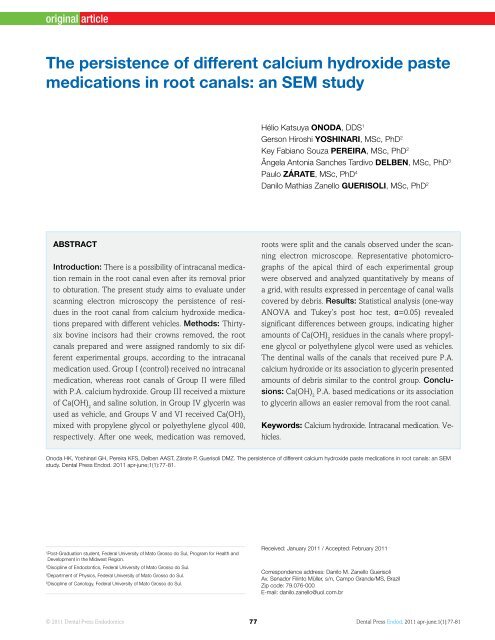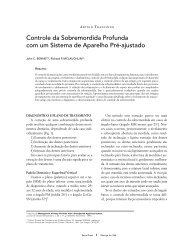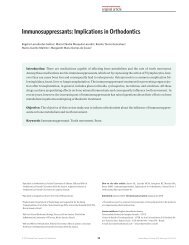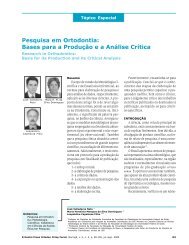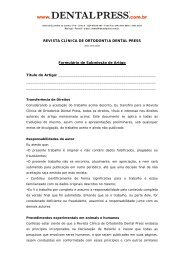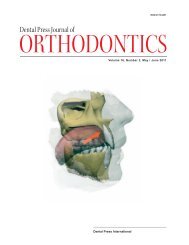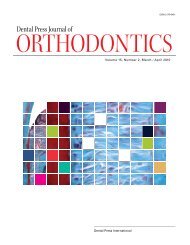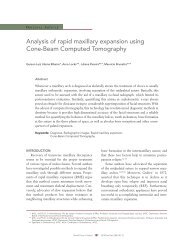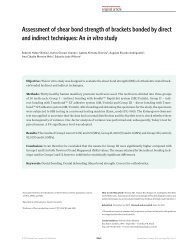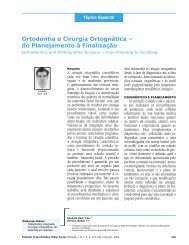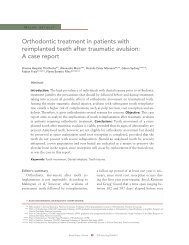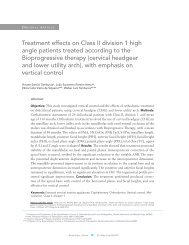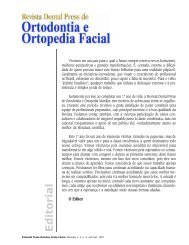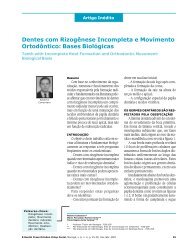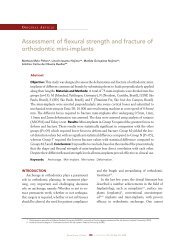Dental Press
Dental Press
Dental Press
Create successful ePaper yourself
Turn your PDF publications into a flip-book with our unique Google optimized e-Paper software.
original article<br />
The persistence of different calcium hydroxide paste<br />
medications in root canals: an SEM study<br />
Hélio Katsuya Onoda, DDS 1<br />
Gerson Hiroshi Yoshinari, MSc, PhD 2<br />
Key Fabiano Souza Pereira, MSc, PhD 2<br />
Ângela Antonia Sanches Tardivo Delben, MSc, PhD 3<br />
Paulo Zárate, MSc, PhD 4<br />
Danilo Mathias Zanello Guerisoli, MSc, PhD 2<br />
Abstract<br />
Introduction: There is a possibility of intracanal medication<br />
remain in the root canal even after its removal prior<br />
to obturation. The present study aims to evaluate under<br />
scanning electron microscopy the persistence of residues<br />
in the root canal from calcium hydroxide medications<br />
prepared with different vehicles. Methods: Thirtysix<br />
bovine incisors had their crowns removed, the root<br />
canals prepared and were assigned randomly to six different<br />
experimental groups, according to the intracanal<br />
medication used. Group I (control) received no intracanal<br />
medication, whereas root canals of Group II were filled<br />
with P.A. calcium hydroxide. Group III received a mixture<br />
of Ca(OH) 2<br />
and saline solution, in Group IV glycerin was<br />
used as vehicle, and Groups V and VI received Ca(OH) 2<br />
mixed with propylene glycol or polyethylene glycol 400,<br />
respectively. After one week, medication was removed,<br />
roots were split and the canals observed under the scanning<br />
electron microscope. Representative photomicrographs<br />
of the apical third of each experimental group<br />
were observed and analyzed quantitatively by means of<br />
a grid, with results expressed in percentage of canal walls<br />
covered by debris. Results: Statistical analysis (one-way<br />
ANOVA and Tukey’s post hoc test, α=0.05) revealed<br />
significant differences between groups, indicating higher<br />
amounts of Ca(OH) 2<br />
residues in the canals where propylene<br />
glycol or polyethylene glycol were used as vehicles.<br />
The dentinal walls of the canals that received pure P.A.<br />
calcium hydroxide or its association to glycerin presented<br />
amounts of debris similar to the control group. Conclusions:<br />
Ca(OH) 2<br />
P.A. based medications or its association<br />
to glycerin allows an easier removal from the root canal.<br />
Keywords: Calcium hydroxide. Intracanal medication. Vehicles.<br />
Onoda HK, Yoshinari GH, Pereira KFS, Delben AAST, Zárate P, Guerisoli DMZ. The persistence of different calcium hydroxide paste medications in root canals: an SEM<br />
study. <strong>Dental</strong> <strong>Press</strong> Endod. 2011 apr-june;1(1):77-81.<br />
1<br />
Post-Graduation student, Federal University of Mato Grosso do Sul, Program for Health and<br />
Development in the Midwest Region.<br />
2<br />
Discipline of Endodontics, Federal University of Mato Grosso do Sul.<br />
3<br />
Department of Physics, Federal University of Mato Grosso do Sul.<br />
4<br />
Discipline of Cariology, Federal University of Mato Grosso do Sul.<br />
Received: January 2011 / Accepted: February 2011<br />
Correspondence address: Danilo M. Zanello Guerisoli<br />
Av. Senador Filinto Müller, s/n, Campo Grande/MS, Brazil<br />
Zip code: 79.076-000<br />
E-mail: danilo.zanello@uol.com.br<br />
© 2011 <strong>Dental</strong> <strong>Press</strong> Endodontics 77<br />
<strong>Dental</strong> <strong>Press</strong> Endod. 2011 apr-june;1(1):77-81


